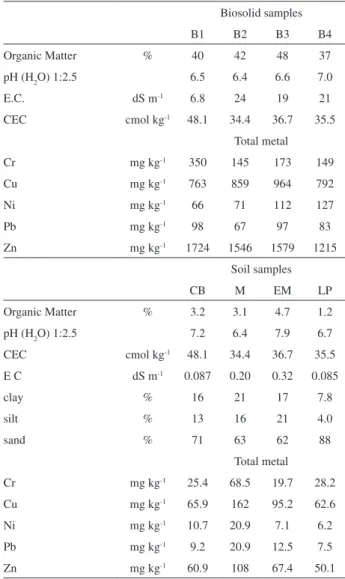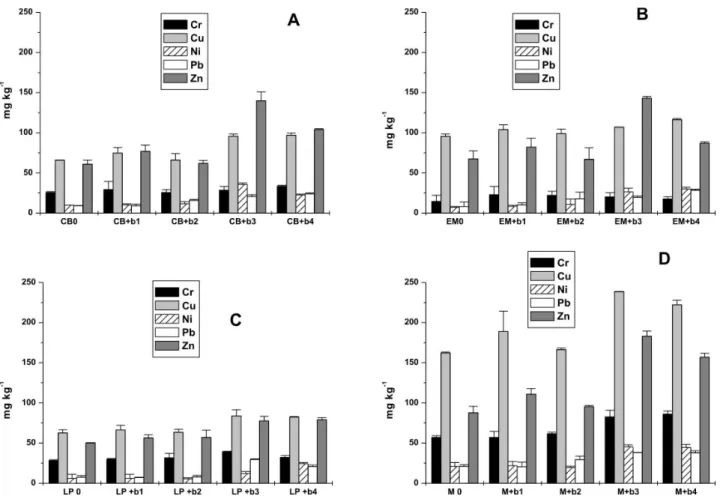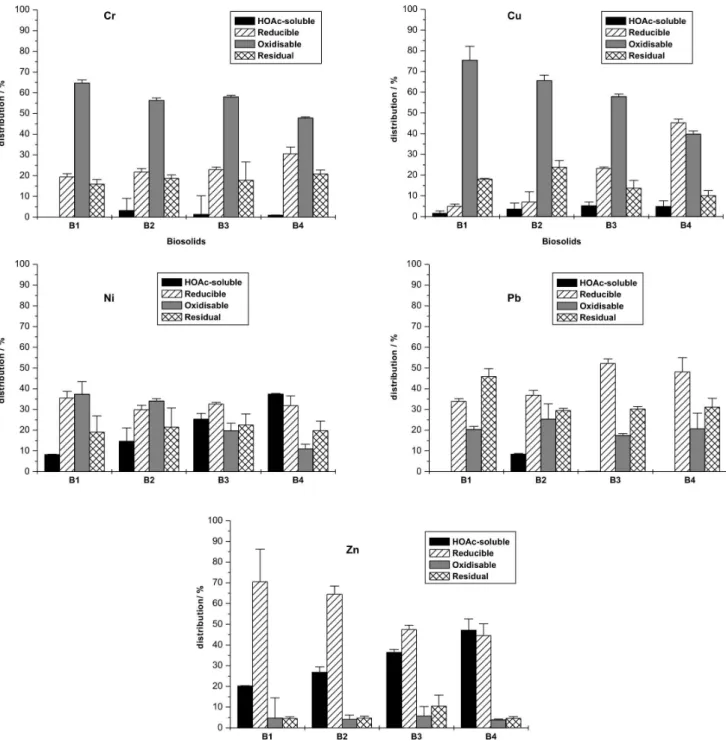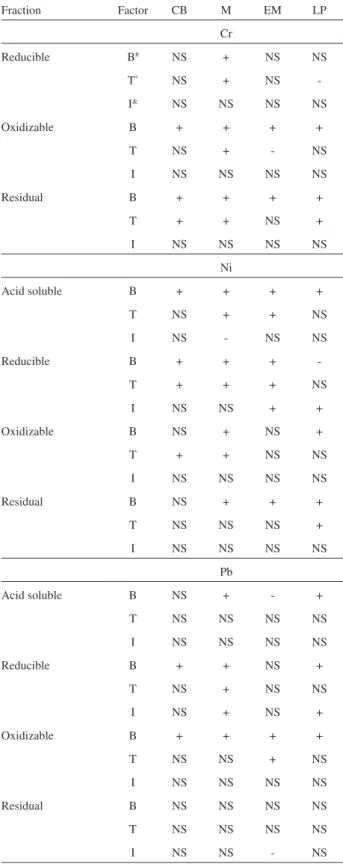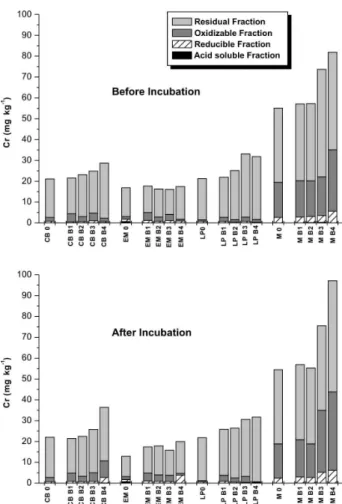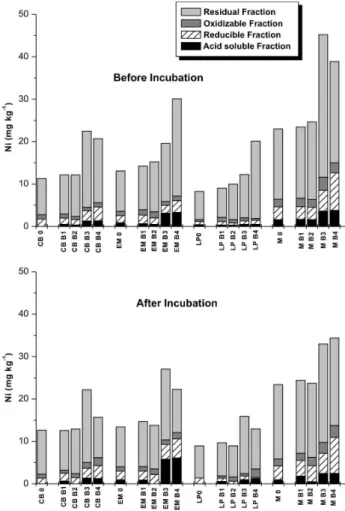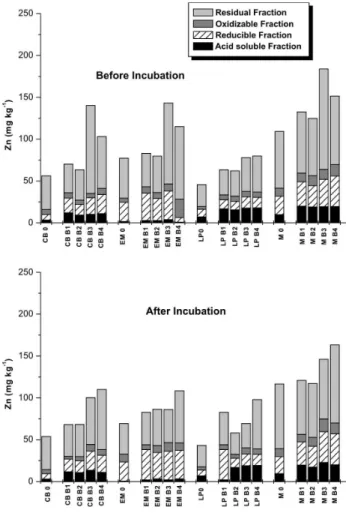Article
0103 - 5053 $6.00+0.00*e-mail: iahumada@ciq.uchile.cl
Assessment of Extractability of Cu, Cr, Ni, Pb and Zn in some Chilean
Biosolid-Amended Soils by using BCR Sequential Extraction Procedure
Inés Ahumada,*,a Adolfo Maricán,a Mauricio Retamal,a Cristina Pedraza,a
Loreto Ascar,a Adriana Carrascob and Pablo Richter a
aFacultad de Ciencias Químicas y Farmacéuticas, Universidad de Chile,
Casilla 233, Santiago, Chile
bFacultad de Ciencias Agronómicas, Universidad de Chile, Casilla 1004, Santiago, Chile
O efeito da aplicação de biossólido na distribuição e extração de Cr, Cu, Ni, Pb e Zn foi avaliado em solos Molisol de uma importante zona destinada à agricultura no Chile central. Massas de 15 e 30 Mg ha-1 de biossólidos foram adicionadas aos solos e os mesmos foram incubados por 60 dias sob condições controladas de umidade e temperatura. Quatro biossólidos domésticos foram obtidos em uma das plantas de tratamento de águas residuárias de Santiago. As extrações sequenciais a partir de amostras de biossólido e solo foram efetuadas de acordo com o procedimento recomendado pelo BCR, que se baseia em quatro extrações para obter uma fração solúvel em ácido (trocável, carbonatos), uma fração reduzível (óxidos de ferro/manganês), uma fração oxidável (matéria orgânica e sulfetos) e uma fração residual. Os metais traço foram determinados por espectrometria de absorção atômica com chama e espectrometria de massa acoplada ao plasma indutivo. Dentre os metais determinados em biossólidos, Zn apresentou a concentração mais alta. A quantidade de metais traço determinada em alguns biossólidos, exceto para Ni, foi abaixo dos limites permitidos pela legislação Chilena para biossólidos. Em geral, desconsiderando-se a fração residual, os metais foram encontrados predominantemente nas frações reduzíveis e oxidáveis. Um planejamento multifatorial foi empregado para avaliar os efeitos da quantidade de biossólido aplicada, do tipo de biossólido e do tempo de incubação. A incorporação do biossólido à razão de 30 Mg ha-1 produziu um aumento na disponibilidade de Zn e Ni em todos os solos e de Cu na maioria deles. Por outro lado, Cr e Pb não variaram signiicativamente. Em geral, os fatores incubação e tipo de biossólido não apresentaram efeitos pronunciados quando comparados com as condições iniciais.
The effect of biosolid application on the distribution and extractability of Cr, Cu, Ni, Pb, and Zn was assessed in Mollisol soils from an important agricultural zone in central Chile. These were amended with biosolids at the amounts of 15 and 30 Mg ha-1 and incubated for 60 days under controlled conditions of moisture and temperature. Four domestic biosolids were obtained from the monoill at one of the Santiago wastewater treatment plants. Biosolid and soil sequential extraction was performed according to the procedure recommended by BCR, which considers four extractions to obtain an acid-soluble fraction (exchangeable, carbonates), a reducible fraction (iron/manganese oxides), an oxidizable fraction (organic matter and sulides) and the residual one.Trace metals were determined by lame atomic absorption spectrometry and inductively coupled plasma mass spectrometry. Among the metals determined in biosolids, Zn had the highest concentration. Total trace metal contents found, except for Ni in some biosolids, was below the limits allowed by the Chilean regulation for biosolids. In general, without considering the residual fraction, the metals were found predominantly as reducible and oxidizable fractions. A multifactorial design was applied to assess the effects of biosolid application amounts, biosolid type and incubation time. Biosolid incorporation at the amount of 30 Mg ha-1 produced an increase in Zn and Ni availability in all soils and Cu in most of them, while Cr, and Pb showed no signiicant variations. In general, the factors incubation and type of biosolid did not show remarkable effects compared with initial conditions.
Introduction
One way of disposal of biosolids generated at wastewater treatment plants is their application to agricultural soils, because these residues are a potential source of organic matter and nutrients for agriculture. In addition, their application to agricultural soils would solve an immediate and future problem of biosolid build-up resulting from the increase, in the last decade, in the number of wastewater treatment plants. Sludge disposal in degraded and eroded soils seems a good alternative for Chile, considering that in our country a great part of the agricultural land shows erosion ranging from serious to slight. Even though there is vast foreign experience on the subject, our country role as producers of a wide variety of agricultural export products makes it necessary to carry out preliminary studies with local soils. Application as a complement to soil fertilization is currently the most common method of biosolid disposal.1,2 Biosolids can be
recycled as a source of nutrients for plant growth and as conditioners to improve physical and microbiological soil properties.3 However, a major obstacle for recycling is that
this residue also contains various contaminants. Metals occurring as trace elements are of special concern because they may present toxic effects in the biota and accumulate in trophics webs.4Mantovi et al.5 found that the application of
biosolids brought about remarkable beneits to soil fertility but it was associated with a possible negative effect on water quality due to increased P availability and on soil ecology due to Zn accumulation.
Total concentrations of heavy metals in soils provide few or none indication about their speciic availability in biosolid-amended soils.6 Moreover, heavy metals can
be associated with solid components and exist in various physicochemical forms that could be determinant on their toxicity, mobility or bioavailability.7 Various procedures
have been developed to determine these associations. Such procedures provide detailed information about metal behaviour in soil. These procedures are usually based on sequential extraction of solid samples with various attacking reagents under deined experimental conditions. One of them is BCR fractionation, developed under the auspices of the Community Bureau of Reference. This constitutes a great advantage, since there is reference material available, which allows control the quality of the measurement.8
The purpose of this study was to determine the effect of biosolid application on the distribution and extractability of the following heavy metals: Cr, Cu, Ni, Pb, and Zn in four soils from an important agricultural zone in central Chile, experimentally amended with anaerobically digested
biosolids, related to potential plant uptake or heavy metal mobility.
Experimental
Soil and biosolid characterization
Four soils were sampled from an agricultural land area near Santiago in Central Chile. Composed surface (0-10 cm) soil samples were drawn. At each site, ive replicates were obtained from each corner and the center of the plot using a stainless-steel hand auger with plastic liner to avoid contamination by chromium or other metals. Samples were mixed, reduced and processed. All samples were air-dried and sieved through a 2 mm mesh-size polyethylene sieve. As concerns soil classiication, all soils are Mollisol order identiied as Coyuncaví Bajo: CB (Lat. S 33º 23’158’’ Long. O 71º 07’1262”), El Maitén: EM (Lat. S 33º 19’902’’ Long. O 70º 51’873 ), La Paloma: LP (Lat. S 33º 19’ 909’’ Long. O 70º 52’ 367’’), and Miralores: M (Lat. S 33º24’ 418’’Long. O 71º 04’ 745’’). Two of them belong to Lampa series (EM and LP) and the other ones to Pomaire (CB) and Chorombo (M), series, respectively. Four biosolid samples differing in storage time in the monoill were obtained from one of the wastewater treatment plants of the Metropolitan Region. They were designated as B1, B2, B3 and B4, with storage times of 12, 6, 3 and 2 months, respectively.
Determination of pH was made using a mixture of soil (or biosolids) and distilled water at a ratio of 1:2.5 m/v with a glass electrode.9 Organic matter was determined by the
Metson method.10 Cation exchange capacity (CEC) was
determined with the sodium acetate method at pH 7.0.11 For
total metal determination, 200 mg of soil or biosolid sample was digested with a mixture of 4 mL HNO3, 4 mL HF, and 2 mL H2O2,using a Milestone/mls 1200 Mega microwave oven. Metals were determined by lame AAS using a 1100 B Perkin-Elmer atomic absorption spectrophotometer or an ICP-MS Fisons VG Plamaquad.
Incubation experiment
The soils were treated with biosolids from a Santiago treatment plant at amounts of 0, 15 and 30 Mg ha-1, and
were incubated at 25 ºC for 60 days under ield capacity moisture conditions.
Metal fractionation
speciic reagents of differing extracting power to obtain the following operationally deined fractions for Cr, Ni, Cu, Zn, and Pb in soils: acetic acid-soluble (20 mL of 0.11 mol L-1 HOAc for 16 h), soluble in reducing condition
(20 mL of 0.50 mol L-1 NH
2OH•HCl adjusted to pH 2 with
HNO3 for 16 h), soluble in oxidizing condition (10 mL of 30% m v-1 H
2O2 digestion and extraction with 25 mL of
1 mol L-1 NH
4OAc pH 5 for 16 h), and residual fraction
(10 mL aqua regia). Depending on its concentration, metal determination in the extracts was performed either using lame AAS or ICP-MS. About 500 mg of each soil, biosolid, and soil-biosolid mixture was accurately weighed in triplicate in a 50 mL centrifuge tube. The reagent corresponding to the step was added, with shaking and centrifugation. The supernatant was separated, iltered and inally stored in polyethylene bottles at 4 ºC until FAAS or ICP-MS analysis. The residues were washed with 10 mL distilled water and the washing was discarded. The centrifuge tubes were weighed for volume correction after each step. For the oxidizable fraction (step 3), the residue from step 2 was oxidized with 10 mL hydrogen peroxide (30% m v-1) in cold for 1 h. and
digestion was allowed to proceed to near dryness at 85 °C by heating the uncovered tube in a water bath. A volume of 40 mL of 0.1 mol L-1 ammonium acetate (adjusted to pH 2
with nitric acid) were added to the cooled residue, which was then shaken for 16 h at room temperature. In order to determine the residual fraction, the recommended extraction protocol with aqua regia (ISO11466) was adapted for microwave oven use. Thus, the residue oxidizable fraction was digested with a concentrated mixture of HNO3 and HCl (1:3 v/v), using a Milestone/mls 1200 Mega microwave oven.
The accuracy of the extraction procedure was checked using a certiied reference material CRM 483.
Statistical analysis
Results were statistically treated with the Statgraphics software through a multifactorial design, considering factors as biosolid rate, biosolid type, and incubation time.
Results and Discussion
Chemical properties of biosolids and soil
Table 1 shows some of the general properties of biosolids and soils. Biosolids show similar values of organic matter ranging from 37 to 48%, normal values usually found in this kind of substrate. The pH values are in the 6.4 to 7 range, corresponding to B1 and B4, respectively.
In relation to heavy metals, except for Ni in biosolids B3 and B4, all values were below those of the Chilean
regulation, which has a limit value of 80 mg kg-1 for this
metal, as well as below the values reported by other authors in similar studies.13 In all the biosolids, Zn and Cu occurred
in the highest concentrations. Organic matter contents range from 1.2 to 4.7%, LP soil exhibiting the lowest values. The values for soil pH were found from slightly acid (6.4) to slightly alkaline (7.9). Like in biosolids, Zn and Cu are predominant in soils, and Ni and Pb show the lowest concentrations. The M soil shows considerably higher concentrations for all heavy metals because it is irrigated with waters contaminated with industrial wastes.
As expected, biosolid application to soil caused an increase in the total content of all the metals. This increase was signiicantly higher for Zn and Cu, due to the high concentrations of these elements found in the biosolid under consideration(Table 1, Figure 1).
It has been found that Zn increase may become risky because of the metal role in controlling the availability of
Table 1. Properties of biosolids and soils under study
Biosolid samples
B1 B2 B3 B4
Organic Matter % 40 42 48 37
pH (H2O) 1:2.5 6.5 6.4 6.6 7.0
E.C. dS m-1 6.8 24 19 21
CEC cmol kg-1 48.1 34.4 36.7 35.5
Total metal
Cr mg kg-1 350 145 173 149
Cu mg kg-1 763 859 964 792
Ni mg kg-1 66 71 112 127
Pb mg kg-1 98 67 97 83
Zn mg kg-1 1724 1546 1579 1215
Soil samples
CB M EM LP
Organic Matter % 3.2 3.1 4.7 1.2
pH (H2O) 1:2.5 7.2 6.4 7.9 6.7
CEC cmol kg-1 48.1 34.4 36.7 35.5
E C dS m-1 0.087 0.20 0.32 0.085
clay % 16 21 17 7.8
silt % 13 16 21 4.0
sand % 71 63 62 88
Total metal
Cr mg kg-1 25.4 68.5 19.7 28.2
Cu mg kg-1 65.9 162 95.2 62.6
Ni mg kg-1 10.7 20.9 7.1 6.2
Pb mg kg-1 9.2 20.9 12.5 7.5
other metals, which, along with soil organic matter and pH, could affect N ixation, nitriication, and decay processes by microorganisms.5,14 Copper increase, instead, seems to
be less critical, in some cases having positive effects on cultivations.15
Sequential extraction of heavy metals in biosolids
Figure 2, shows heavy metals (Cr, Cu, Ni, Pb and Zn) fractionation in biosolid samples. It may be seen that Cr and Cu are mainly found associated to the oxidizable fraction, while Zn and Pb occur predominantly in the reducible form. It should be noted that for Ni and Zn, the acid-soluble fraction (soluble, exchangeable, and carbonate forms), which could correspond to the labile form of the metal, is also important, becoming the predominant fraction in biosolid B4 with values of almost 40 and 50% of total content, respectively. Similar results were found by McLaren and Clucas,16 in a fractionation study of Cu,
Ni, and Zn in metal-spiked sewage sludge. They found that addition of higher levels of Ni and Zn resulted in greater proportions of the metals in the most soluble fraction. García-Delgado et al.17 found a high proportion of Ni and
Figure 1. Total metal content of Cr, Cu, Ni, Pb and Zn in control soils and soils amended with biosolids (b1, b2, b3, b4) at rate of 30 Mg ha-1. A: CB soil;
B: EM soil; C: LP soil; D: M soil.
Zn in the available form in sewage sludges from various wastewater treatment plants.
On the other hand, the irst fraction of the sequential extraction procedure (Figure 1) for Cu, Ni, and Zn in the biosolids is highly dependent on storage time in the monoill. The concentrations of these metals decreased in the following order B4 > B3 > B2 > B1, showing that lability decreases with storage time. According to these results, metal fractionation in biosolids could be a mean to estimate metal transport to soil when this substrate is utilized as amendment as well as to predict possible contamination by these elements. However, it should be considered that when these substrates are applied to soil there may be other factors affecting metal availability in soil, which suggest that complementary studies should be carried out in the future.
Sequential extraction of heavy metals in soils
and consequently increased plant uptake of Cu and Zn. However, our results showed that the effect of incubation was low. This could be due to the fact that the two-month time period was not enough to produce organic matter breakdown and to increase metal lability. Keller et al.20
detected, in soils treated with biosolids, an increase in soluble organic matter after 30 months and postulated that organic matter breakdown would account for the increase in the mobility of trace metals.
Multifactorial analysis (Tables 2 and 3) was carried out in order to assess the effect of biosolid application on metal
Figure 2. Fractionation of Cr, Cu, Ni, Pb and Zn in biosolids (B1, B2, B3, B4).
metals would be in a less extractable or unavailable form, possibly associated to clay minerals.18 Without including
the residual fraction, the metals were distributed mainly in the oxidizable and reducible fractions. The prevalence of one or another form is dependent on the metal and soil. It was found that the biosolid amount produced a positive increase in the acid-soluble fraction of Cu, Ni and Zn, which would correspond to the most labile form of these metals, as established above. Other authors such as Luo and Christie,19 found that sludge application usually
distribution in soils, considering biosolid amount (0 and 30 Mg ha-1), biosolid type (B1, B2, B3, B4) and incubation.
Chromium
Chromium in control soils was mainly found in the residual form and for M soil the oxidizable form of this element was also important, with 28% of the total Cr sequentially extracted, or sum of the four fraction values. As previously stated, most of the total Cr would be found associated to clay minerals, which would account for its low extractability (Figure 3). Incorporation of the various biosolids did not increase Cr extractability (Table 2), since; in general, a high proportion of this element remained in
Table 2. Multifactorial design analyses for the effects of biosolid application (B), type of biosolid (T) and incubation (I) on Cr, Ni and Pb fractionation
Fraction Factor CB M EM LP
Cr
Reducible B# NS + NS NS
T* NS + NS
-I& NS NS NS NS
Oxidizable B + + + +
T NS + - NS
I NS NS NS NS
Residual B + + + +
T + + NS +
I NS NS NS NS
Ni
Acid soluble B + + + +
T NS + + NS
I NS - NS NS
Reducible B + + +
-T + + + NS
I NS NS + +
Oxidizable B NS + NS +
T + + NS NS
I NS NS NS NS
Residual B NS + + +
T NS NS NS +
I NS NS NS NS
Pb
Acid soluble B NS + - +
T NS NS NS NS
I NS NS NS NS
Reducible B + + NS +
T NS + NS NS
I NS + NS +
Oxidizable B + + + +
T NS NS + NS
I NS NS NS NS
Residual B NS NS NS NS
T NS NS NS NS
I NS NS - NS
NS: no signiicant effect; +: the parameter increased signiicantly with biosolid incorporation, type of biosolid, or incubation (p < 0.05); -: the parameter decreased signiicantly with biosolid incorporation, type of biosolid or incubation (p < 0.05).
Table 3. Multifactorial design analyses for the effects of biosolid amount (B), type of biosolid (T) and incubation (I) on Cu and Zn fractionation
Fraction Factor CB M EM LP
Cu
Acid soluble B + + + NS
T NS NS NS NS
I NS NS NS +
Reducible B + + + +
T NS + NS NS
I NS NS NS NS
Oxidizable B + + + +
T + + + NS
I NS NS NS NS
Residual B + + NS NS
T NS + NS +
I NS NS NS NS
Zn
Acid soluble B + + + +
T NS NS NS NS
I NS NS NS NS
Reducible B + NS NS +
T NS NS NS NS
I NS NS NS NS
Oxidizable B NS NS NS +
T NS NS NS NS
I NS NS NS NS
Residual B NS NS + +
T NS NS + NS
I NS NS - NS
the residual fraction. In relation to the reducible fraction, biosolid incorporation increased this fraction only in M soil, while the oxidizable and residual fractions, on the contrary, increased in all soils, and they were also dependent on biosolid type (Figure 3). In general, the incubation process had no signiicant effect on this metal.
Copper
Figure 4 shows that the oxidizable fraction of this metal in relation to control soils, followed the residual fraction in almost all of the soils except for M soil. In addition, this soil showed an important content of this metal in the acid-soluble form. For all soils, the acid-acid-soluble Cu fraction, accounted for the smallest amount of total content, and biosolid incorporation generated a statistically signiicant increase in this fraction in CB, EM, and LP soils (Table 3). It was also found that biosolid application increased the reducible and oxidizable form in all soils, and this response was dependent on the type of biosolid applied (Table 3). The residual fraction in CB and M soils increased signiicantly and is depended on biosolid type (Table 3). Incubation produced a signiicant increase only in the irst fraction
of LP soil. Even though incubation time would not be appropriate to see changes in Cu distribution caused by organic matter breakdown, other authors,21 have found,
in relation to Cu, that application of biosolids to alisol and vertisol soils incubated for 7 years at rates of up to 250 Mg ha-1, is not likely to pose any environmental risks
in short to medium terms.
Nickel
This is one of the metals occurring in the lowest concentration and, as previously stated, it occurs mainly in the most inert form, just a small proportion is in the reducible and oxidizable fractions. Like other metals, a low concentration of Ni in labile form was determined, M soil standing out with the highest value, near 6% of the sequentially extracted total for this metal (Figure 5). Table 2 shows that biosolid amendment caused a signiicant increase in the most labile fraction of this element, thus increasing its availability in all soils. In M and EM soils, it was found that this response varied signiicantly with the type of biosolid. In addition, with the exception of LP soil, the reducible fraction in all the soils and oxidizable
Figure 3. Fractionation of Cr in CB, EM, LP and M soils treated with biosolids (B1, B2, B3, B4) at rates 0 and 30 Mg ha-1 before and after
incubation.
Figure 4. Fractionation of Cu in CB, EM, LP and M soils treated with biosolids (B1, B2, B3, B4) at rates 0 and 30 Mg ha-1 before and after
one in M and LP soils increased signiicantly upon biosolid application. An increase was also observed in the residual fraction in almost all soils, but the response for LP soil was independent of biosolid type. After incubation, a signiicant increase was found only in the reducible fraction of EM and LP soils. No statistically signiicant changes were observed in the residual fraction of all soils.
Lead
In control soils, this metal is mainly found in the inert form, possibly associated to clay minerals (Figure 6). Biosolid incorporation increased the acid soluble and reducible fractions in M and LP soils (Table 3). Biosolid incorporation, instead had a signiicant effect, increasing the oxidizable lead fraction in all soils, but this effect was dependent on biosolid type in M soil. Incubation had a positive effect on the reducible fraction in all soils.
Zinc
Zinc was found distributed in control soils throughout the fractions, generally following the same order: residual >
reducible > oxidizable > acid soluble. It should be pointed out that in LP soil the reducible form of Zn was similar to the most labile form, and in CB soil the latter and the oxidizable fraction exhibit the same values, accounting for 4% of total sequentially extracted Zn (Figure 7). Biosolid application increased Zn availability, since the acid soluble fraction of Zn increased when the soils were treated with different biosolids (Table 3). It was also found that the Zn reducible fraction also increased after biosolid incorporation (Table 3), but this increase was not signiicant in M and EM soils. Biosolid incorporation increased the residual fraction in EM and LP soils, but in EM soil this result is depended on biosolid type. Other authors,22,23 have demonstrated that the exchangeable
and carbonate Zn fraction would correspond to the bioavailable forms. Qiao et al.24 found that available Zn was much higher
than Cu in both soils of their study. They explained that this may be due to differences in chemical characteristics between Cu and Zn. Copper can be preferably combined with organic matter while Zn appears to be more sensitive to soil acidity. In our case, EM soil had the highest pH and incorporation of biosolids of usually neutral pH would not be enough to
Figure 5. Fractionation of Ni in CB, EM, LP and M soils treated with biosolids (B1, B2, B3, B4) at rates 0 and 30 Mg ha-1 before and after
incubation.
Figure 6. Fractionation of Pb in CB, EM, LP and M soils treated with biosolids (B1, B2, B3, B4) at rates 0 and 30 Mg ha-1 before and after
Figure 7. Fractionation of Zn in CB, EM, LP and M soils treated with biosolids (B1, B2, B3, B4) at rates 0 and 30 Mg ha-1 before and after
incubation.
produce a change in pH leading to signiicant increase in the most labile Zn fraction in this soil. Incubation had a signiicant negative effect on the residual fraction in EM soil.
Conclusions
Among the metals determined in biosolids, Zn had the highest concentration. Total trace metal contents found were below the limits allowed by the Chilean regulation for biosolids. The largest proportion of total metal was found in the residual fraction and in fractions more resistant to extraction, indicating that the metals were in more stable form and are consequently considered unavailable for plant uptake. Biosolid application increased the total content of all metals under study. In general, without considering the residual fraction, metals were found predominantly as reducible and oxidizable fractions.
A multifactorial design was applied to assess the effects of biosolid application, type of biosolid and incubation time on metal extractability and distribution. The incubation process and type of biosolids did not
show remarkable effects. Biosolid incorporation at the amount of 30 Mg ha-1 produced an increase in Zn, Cu and
Ni availability in most soils, while Cr and Pb showed no signiicant variations.
Acknowledgments
The authors would like to thank the inancial support from FONDECYT Project No. 1080357.
References
1. Epstein, E.; Land Application of Sewage Sludge and Biosolid,
Lewis Publishers, CRC Press: Boca Raton, FL, USA, 2003. 2. Moffet, C. A.; Zartman, R. E.; Wester, D. B.; Sosebee, R. E.;
J. Environ. Qual.2005, 34, 299.
3. Jurado-Guerra, P; Wester, D. B.; Fish, E. B.; J. Environ. Qual. 2006, 35, 641.
4. Kabata-Pendias, A.; Pendias, H.; Trace Element in Soils and Plants, 3rd ed., CRC Press: Boca Raton, FL, USA, 2001.
5. Mantovi, P.; Baldoni, G.; Toderi, G.; Water Res.2005, 39, 289. 6. McBride, M. B.; J. Environ. Qual.1995, 24, 5.
7. Ure, A.; Quevauviller, Ph.; Muntau, H.; Griepink, B.; Int. J. Environ. Anal. Chem.1993, 51, 135.
8. Sutherland, R. A.; Tack, F. M. G.; Anal. Chim. Acta2002, 454, 249.
9. Mc Lean, E. O. In Methods of Soil Analysis, Part 2, 2nd ed., Page, A. L.; Miller, R. H.; Keeney, D. R., eds.; American Society of Agronomy: Madison, WI, 1982, p. 199.
10. Blackemore, L. C.; Searle, P. L.; Daly, B. K.; In Methods for
Chemical Analysis of Soils, N Z Soil Bureau Scientiic Report
80, 1987, p.18.
11. Jackson, M.L.; In Análisis Químico de Suelos, Ediciones Omega, S.A.: Barcelona, España. p 102.
12. Rauret, G.; López-Sánchez, J. F.; Sahuquillo, A.; Barahona, E.; Lachica, M.; Ure, A. M;. Davidson, C. M; Gomez, A.; Lück, D.; Bacon, J.; Yli-Halla, M.; Muntau, H.; Quevauviller, Ph.;
J. Environ. Monit. 2000, 2, 228.
13. Zuiaurre, R.; Olivar, A.; Chamorro, P.; Nerón, C.; Callizo, A.;
Analyst1998, 123, 255.
14. Bhogal, A.; Nicholson, F. A.; Chambers, B. J.; Shepherd, M. A.; Environ. Pollut. 2003, 121, 413.
15. Gaskin, J. G.; Brobst, R. B.; Miller, W. P.; Tollner, E. W.;
J. Environ. Qual.2003, 32, 146.
16. McLaren, R. G., Clucas, L. M.; J. Environ. Qual. 2001, 30, 1968.
17. García-Delgado, M.; Rodríguez-Cruz, M. S.; Lorenzo, L. F.; Arienzo, M.; Sánchez-Martín, M. J.; Sci. Total Environ. 2007,
382, 82.
20. Keller, C.; McGrath, S. P.; Dunham, S. J.; J. Environ. Qual. 2002, 31, 1550.
21. Olivier, I. W.; Hass, A.; Merrigton, G.; Fine, P.; McLaughlin, M. J.; J. Environ. Qual. 2005, 34, 508.
22. Hseu, Z- Y.; Chemosphere2006, 63, 762.
23. Guerra, P.; Ahumada, I.; Carrasco, A.; Chemosphere2007, 68, 2001.
24. Qiao, X. L.; Luo, Y. M.; Christie, P.; Wong, M. H.; Chemosphere 2003, 50, 823.
Received: January 30, 2009
